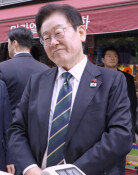A vestige of ancient life at Chonghak-dong on Mt. Chiri
A vestige of ancient life at Chonghak-dong on Mt. Chiri
Posted March. 08, 2001 18:35,

In a valley where small straw-thatched cottages form a little knot of togetherness, residents work, study and live their everyday lives while wearing topknots (``sangtu``), pigtail ribbons and ``hanbok`` (traditional Korean clothes). But it was not that long ago that the village was overcome with fears of impending changes as Western-style stores, a big private school for the study of Chinese classics, restaurants, tearooms and other modern facilities totally changed its appearance.
Thousands of students spend several days in the village each year to attend special courses at the private school, known as a ``sodang.`` Statistics show the number of visitors to this new tourist destination exceeded one million last year. So far, the fears of revolutionary changes in the village have proved to be largely unfounded. Nonetheless, it is feared that some people visiting ``Doinchon``, or Tao seekers` village may recall the sad story of ``mountain girl Young-Ja.`` Young-Ja was a 19-year-old girl who had lived a secluded life in a remote mountain district in Kangwon-do and became a sort of Cinderella after an account of her lonely life was broadcast in a KBS TV documentary last July. She was soon recruited as a model for a mobile phone service provider and went to Seoul to study, leaving her 50-year-old father behind. Her father was recently found dead in their isolated house and police suspect he was murdered.
But entering the village, the visitors will feel at ease because it still gives the impression of being a place where the villagers live simple, free and easy lives. At present, there are about 180 members of 26 households living in the village. Entering a straw-thatched hut near the gate, visitors will find works of calligraphy on ``Great Luck on Ipchun`` (the first day of spring by the traditional Korean calendar, which fell on Feb. 4 this year), on the pillars of the main room and rubber shoes on the stepstone. The food on offer ranges from steamed rice in bamboo bowls, cold noodles containing powdered bamboo leaves, ``pibimbap`` made of wild greens from Mt. Chiri and liquor made from fruits in bamboo bottles. The latter comes in five varieties based on taste: sour, bitter, pungent, sweet or salty.
News of spring in Chonghak-dong seems to be delivered by sap from ``koroshoe`` trees rather than by the blooming of flowers. Villagers hold a festival to advertise the season’s first sap, which they extract in the high land more than 1,000 meters above sea level. A 20-liter bottle of koroshoe sap is priced at 45,000 won. For further information, call Lee Sung-Ku at 054-883-8140.
As ``sodang`` gains wider popularity as a form of alternative education, the number of private schools based on model of the Choson Kingdom (1392-1910) continues to grow. Mt. Chiri Chonghak-dong Sodang Institute is the sole non-profit corporation. It is run by 11 teachers led by Lee Hak-Kyu, the keeper of Chonghak Sodang, the only traditional sodang in the village. Instructors live with their students in the sodang and teach them traditional games, calligraphy, courtesy and humanity. The tuition fee is 10,000 won a day. The school offers a variety of courses like a four-day experience program for 62,000 won and a two-week training course.
For further information, go to www.chunghak.net or call 055-884-5975/6.
- How to get Chonghak-dong Village
By car: Seoul-Taejon-Chonju-Namwon-Kurye-Hadong-Hoengchon-myon(six to seven hours); Pusan-Namhae Highway-Chinju-Hwoengchon-myon (two and a half hours); Taegu-Kuma Highway-Namhae Highway-Chinju-Hoengchon (three hours)
Public transport: Buses depart for Chunghak-dong at the inter-city bus terminals in Chinju and Hadong.
Travel agency: Seungwoo Tour Co. (822-720-8311) presents a two-day sleepless tour program to ``Chunghak-dong Doinchon`` that also covers Maehwa Village and Poriam Temple in Kumsan. (www.seungwootour.co.kr).
Cho Seong-Ha summer@donga.com







